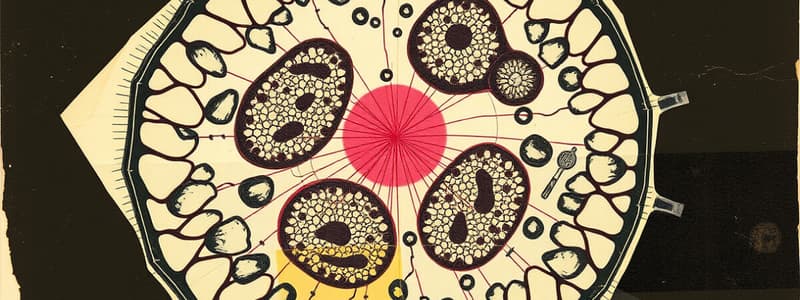Podcast
Questions and Answers
What controls what enters and leaves the cell?
What controls what enters and leaves the cell?
- Lysosome
- Ribosome
- Nucleus
- Cell membrane (correct)
What is the function of the smooth endoplasmic reticulum?
What is the function of the smooth endoplasmic reticulum?
Makes lipids for the cell membrane and detoxifies the cell.
What is the role of rough endoplasmic reticulum?
What is the role of rough endoplasmic reticulum?
Makes and modifies proteins.
What does the Golgi apparatus do?
What does the Golgi apparatus do?
What is the function of lysosomes?
What is the function of lysosomes?
What are microtubules?
What are microtubules?
What is the main function of mitochondria?
What is the main function of mitochondria?
What does the nucleus hold?
What does the nucleus hold?
What is the role of ribosomes?
What is the role of ribosomes?
What does the nucleolus produce?
What does the nucleolus produce?
What is cytoplasm?
What is cytoplasm?
What does the large, central vacuole store?
What does the large, central vacuole store?
What is the function of the cell wall?
What is the function of the cell wall?
What do chloroplasts do?
What do chloroplasts do?
Study Notes
Key Cell Components
-
Cell Membrane
- Semipermeable barrier controlling entry and exit of substances
- Composed of phospholipid bilayer
-
Smooth Endoplasmic Reticulum (SER)
- Synthesizes lipids for cell membrane
- Detoxifies harmful metabolic byproducts
-
Rough Endoplasmic Reticulum (RER)
- Studded with ribosomes for protein synthesis and modification
-
Golgi Apparatus
- Processes, sorts, and packages proteins for secretion
- Involved in the cell’s export activities
-
Lysosome
- Contains digestive enzymes to break down large macromolecules
- Plays a key role in waste disposal and recycling
-
Microtubule
- Essential part of the cytoskeleton providing structural support
- Helps in cell shape maintenance and intracellular transport
-
Mitochondria
- Known as the powerhouse of the cell
- Converts glucose into ATP (adenosine triphosphate) for energy
-
Nucleus
- Central organelle housing genetic material (DNA)
- Regulates cellular activities such as growth and reproduction
-
Ribosome
- Site of protein synthesis
- Can be found floating freely in the cytoplasm or attached to the RER
-
Nucleolus
- Located within the nucleus, responsible for ribosome production
- A dense region crucial for ribosomal RNA synthesis
-
Cytoplasm
- Gel-like substance filling the cell, allowing organelles to remain in place
- Medium for biochemical reactions and cellular processes
-
Large Central Vacuole
- Storage center for water, salts, nutrients, and proteins
- Maintains cell turgor pressure in plant cells
-
Cell Wall
- Rigidity and strength, providing structural support to the plant cell
- Located outside the cell membrane, composed mainly of cellulose
-
Chloroplast
- Organelles that perform photosynthesis, converting light energy into chemical energy
- Contains chlorophyll, the pigment responsible for green color and light absorption
Studying That Suits You
Use AI to generate personalized quizzes and flashcards to suit your learning preferences.
Description
Explore the essential components of animal and plant cells with this engaging set of flashcards. Each card includes a key term and its definition, helping you understand the functions of various cell structures. Perfect for biology students or anyone looking to enhance their knowledge of cellular biology.




